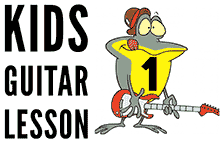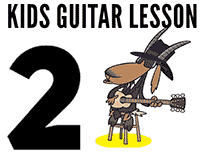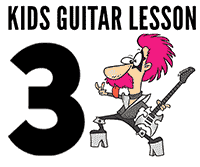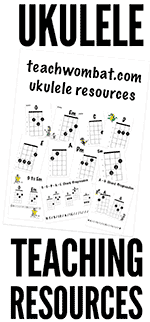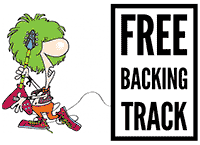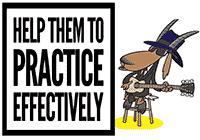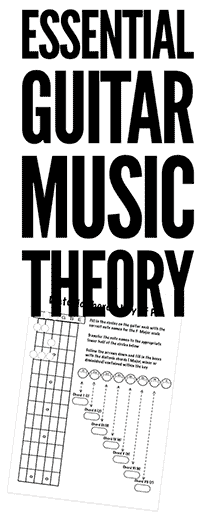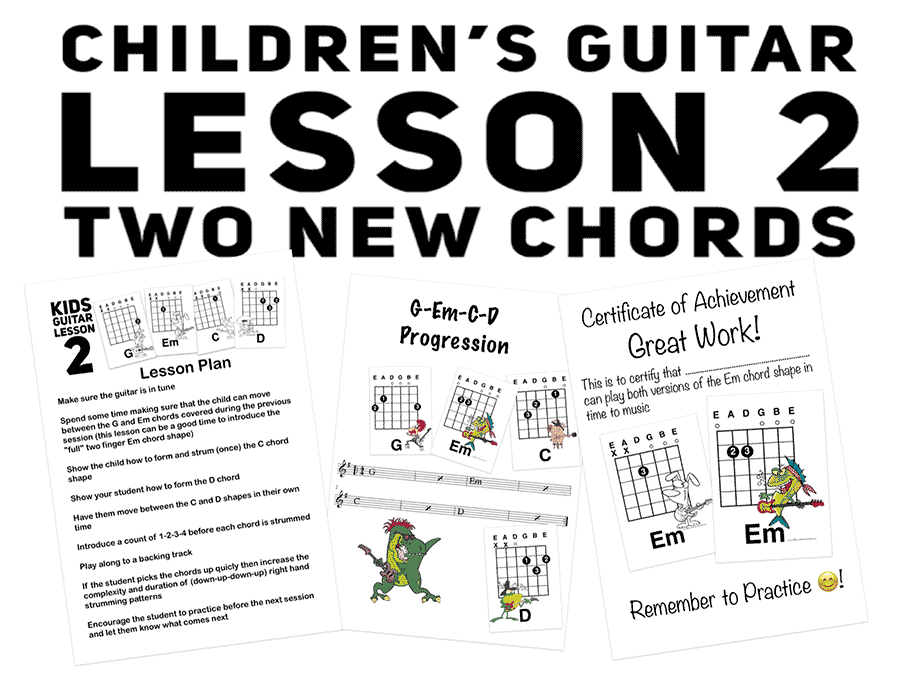
Teaching Kids Guitar Chords
Child's Guitar Lesson-1
Kids Guitar Lesson 2
Child's Guitar Lesson-3
Child's Guitar Lesson-4
Child's Guitar Lesson-5
Second Children's Guitar Lesson building on the progress made during lesson 1 by introducing two new chords
During the First Kid's Guitar Lesson a child will have become familiar with forming two of the eight chord shapes (G and Eminor) that a beginner should learn first. This second lesson sets out to reinforce the knowledge and capabilities developed during the first session and adds two new chords (C and D) to the mix as well as introducing kids to the full Em chord shape (you can print a free certificate designed to reward progress from this page).

Download the easy to follow PDF lesson plan for this session (shown above) to your phone, tablet or PC
Kids Guitar Lesson 2: Lesson Plan
Lesson Objectives...
1: Make sure that your student can remember and play the G and Em chords from lesson no 1
2: Introduce two new chords (D and C) and a backing track featuring them
3: Use all four chords covered to this point with a single backing track
The Lesson
As before the start of a kids guitar or ukulele lesson or practice session (we also have a range of resources for teachers who wish to use ukuleles rather than guitars that can be used as a stand-alone or alongside the guitar resources if both instruments are to be used in a single session) you should make sure the child's guitar is in tune
Before you start this lesson recap the first one and address any problems
At the beginning of this session it is a good idea to ensure that a child has retained the knowledge (of the two chord shapes) and the capability (playing them in time to a backing track) that they worked on in the first lesson
Do not worry or become discouraged as a teacher if they are still having trouble remembering the chord shapes that you showed them during the course of the last lesson. They are kids and forgetting stuff (like cleaning their teeth or taking gym kit to school) is what they do.
Remember the "Guitar Teacher's Mantra" which is something like "By the end of the lesson they will not be playing perfectly but they will be playing better". Gradual progress is what we are looking for here and during these early stages it is best not to get hung up on a quest for perfection. To look into the idea of teaching kids to play the guitar
in greater detail you could follow the link and take a look at our page that gives an overview of the whole subject.
If your student still has trouble remembering the G and Em shapes then spend as long as is required (even if it is the entire lesson) making sure that they can change between the two shapes in time to music (or at the very least a metronome).

Step 1: Review (one finger) G and Em chords covered in the first lesson
This is a very important principle for all guitar teachers (not just those who teach younger students) Looking at the stuff from the last lesson at the start of the current one gives you a great idea of where the student really is (as opposed to where they say or think they are) Make sure that they can remember (and strum) the one finger versions of the G and Em chords covered in the first lesson

Step 2: Introduce the "full" Em Chord shape
This is an ideal opportunity to build upon the knowledge and capabilities developed in the first lesson. Before you introduce the new chords (C and D) you can ask the child to work on the full (two finger) version of the Em chord shape
This will present no real problems in terms of stretching as the notes that are found on the two strings that need to be fretted to produce the chord are right next to one another. All that your student needs to do to learn the new shape is to add a finger to the Em shape they can already play
Another Free Certificate!
Here is another free certificate themed around being able to form the "full" chord shape that you can print and hand out to your students
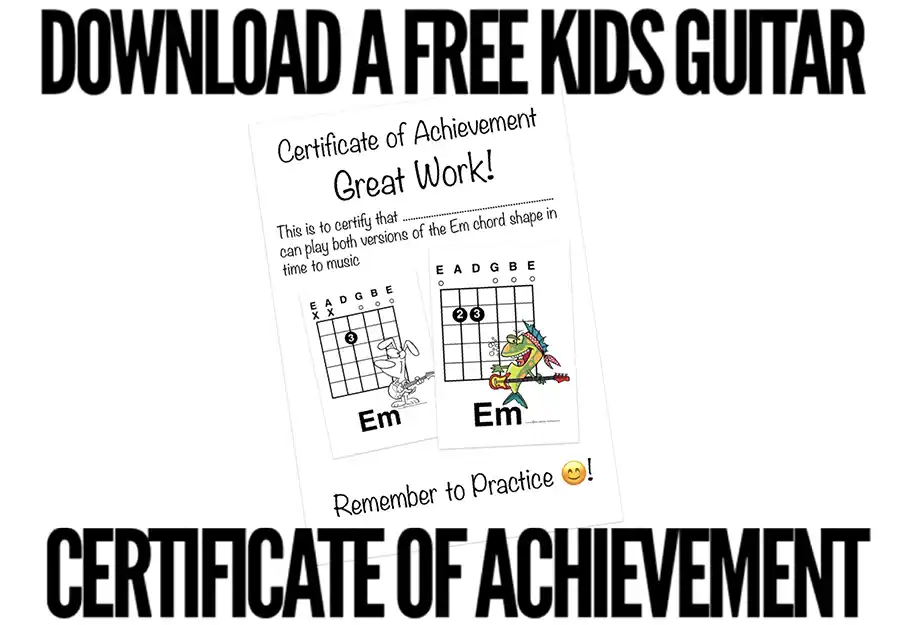
If you decide to go with the "full" Em chord shape (and you should because its an "easy win") use the Free certificate of achievement (shown above) which recognises the child's ability to play the full Em shape

Step 3: Introduce the C chord shape
The "reduced" one finger C shape shown above can be used here. Be sure to make the child aware that they should only strike the three thinnest strings when sounding this version of the chord

Step 4: Introduce the D chord shape
The D chord shape is another that does not require a "reduced" shape as all of the fingers are grouped together and there is really no stretching required
Step 5: Encourage a child to move between the shapes in their own time
Spend a while on this stage in order to ensure that your student(s) can remember the shape without having to refer to the chord sheets. All you really need to do is make sure that they can move freely between the chords. We are going to be looking at a chord sequence that goes from G to Em and from there to C and then D but I can't stress enough that kids should be encouraged at this stage to see the chords as being distinct from each other rather than as part of any pre ordained sequence
Step 6: Use a count of 1-2-3-4 to help your student to play in time
Using the method employed during Kids Guitar Lesson 1 (where the teacher counts "1-2-3-4" and the student strums the specified chord once where "5" would be) make sure that the student becomes familiar with playing chords "in time" This is not just important for children. Many adults spend a lot of time learning chords and studying the guitar without grasping the importance of actually paying attention to "when" they are playing (as opposed to merely what they are playing?). "The right chord at the wrong time is the wrong chord"
A New Children's Guitar Backing Track
Before a child is tasked with playing all four chords learned so far in a single sequence they can be invited to work with a new backing track (that you can hear a snippet of below) that cycles between the two new chords Smaller children can use the "one finger" version of the C chord if required
Hear the D to C Backing Track

Then its time for.........
All four chords in a single progression

Step.7: Use the G-Em-C-D Backing Track

Play a short extract from the backing track
The G Em C and D backing track that forms a small part of the teachwombat resources features a bass and drum accompaniment to a repeated eight bar chord sequence. in the first instance ask the child (or children if you are teaching group lessons) to play a single downward strum for each chord as it changes and again count them ("1-2-3-4")into each chord change as appropriate. The handout that you can see above uses the one finger version of the Em chord but you can of course use the full version of the Em chord if you elected to introduce it during the course of this lesson
Step 8: Introduce more "complex" right hand strumming patterns
When they have mastered playing a single chord in time you can introduce more complicated (down-up-down-up) strumming patterns being careful to keep the strumming at the beginning of each two bars of each chord leaving a child plenty of time to slowly chamge between shapes
You can find out more about strumming patterns for kids by taking a look at this video
The Video Will Start From Kid's Guitar Lesson 2
Step 9: Review the lesson and let them know what you will be covering next
It is important to stress that all children are different and pick up and internalise things at different rates. Some kids will get this very quickly but will then forget it just as swiftly. Others will struggle and take longer but the information and capability will stay with them for a lifetime. This material is presented here as a series of lessons but it is really just a sequence of topics to cover in a sensible and sequential fashion.
Important!...
Do not get too hung up on the "Lesson 1-Lesson 2-Lesson 3" thing. What you need to ensure by this stage is that a child can play single strums on four chords in time to music. If that takes three, four or more sessions do not worry at all.
Most people who try to learn to play guitar give up not because they don't want to learn badly enough (they do!) but because they try to learn the "wrong" stuff
I have lost count of the times that when finding out what I do for a living someone says "I love music but can't play an instrument because I have not got a musical bone in my body" or "I took a few lessons when I was younger but I was no good at it so I gave up" The reality is that they tried to play the "wrong" material when learning or that they did not practice enough (and it does not take very long) in the early stages of study to build a basic level of competence. As teachers it is important that we remember that what we are trying to do is make our students better (not make them perfect).
At this stage there are only two real problems that you and your student will come up against The first is that they cant change chords quickly enough and the second is that sometimes their fingers will "kill" strings that they want to have ring out Both of these problems are solved by working along with backing tracks First to play just a single chord and then to work on more complicated strumming patterns
It really is that simple

The Deluxe Package:
Download all of our products for just $25.00
HOW TO DOWNLOAD
the Guitar and bass teacher's Toolkits
Buy your teachwombat.com toolkits in complete safety via any major credit card (through paypal) or directly through your paypal account if you have one. If you choose to use a credit card, rest assured that we never see your credit card details as paypal do all of that for us.
When Paypal receive your payment you will be immediately invited to click a
"RETURN TO MERCHANT"button.
You will be taken to a page from where you can download the products that you have paid for NOW!
In the (rare) event that something should go wrong with the order/download process just email me at robh@teachwombat.com
I will check the order and send you the links that will get you to your stuff.
Cheers! Rob!
Child's Guitar Lesson-4
Child's Guitar Lesson-5
Child's Guitar Lesson-5
Second Children's Guitar Lesson building on the progress made during lesson 1 by introducing two new chords
During the First Kid's Guitar Lesson a child will have become familiar with forming two of the eight chord shapes (G and Eminor) that a beginner should learn first. This second lesson sets out to reinforce the knowledge and capabilities developed during the first session and adds two new chords (C and D) to the mix as well as introducing kids to the full Em chord shape (you can print a free certificate designed to reward progress from this page).

Download the easy to follow PDF lesson plan for this session (shown above) to your phone, tablet or PC
Kids Guitar Lesson 2: Lesson Plan
Lesson Objectives...
1: Make sure that your student can remember and play the G and Em chords from lesson no 1
2: Introduce two new chords (D and C) and a backing track featuring them
3: Use all four chords covered to this point with a single backing track
The Lesson
As before the start of a kids guitar or ukulele lesson or practice session (we also have a range of resources for teachers who wish to use ukuleles rather than guitars that can be used as a stand-alone or alongside the guitar resources if both instruments are to be used in a single session) you should make sure the child's guitar is in tune
Before you start this lesson recap the first one and address any problems
At the beginning of this session it is a good idea to ensure that a child has retained the knowledge (of the two chord shapes) and the capability (playing them in time to a backing track) that they worked on in the first lesson
Do not worry or become discouraged as a teacher if they are still having trouble remembering the chord shapes that you showed them during the course of the last lesson. They are kids and forgetting stuff (like cleaning their teeth or taking gym kit to school) is what they do.
Remember the "Guitar Teacher's Mantra" which is something like "By the end of the lesson they will not be playing perfectly but they will be playing better". Gradual progress is what we are looking for here and during these early stages it is best not to get hung up on a quest for perfection. To look into the idea of teaching kids to play the guitar
in greater detail you could follow the link and take a look at our page that gives an overview of the whole subject.
If your student still has trouble remembering the G and Em shapes then spend as long as is required (even if it is the entire lesson) making sure that they can change between the two shapes in time to music (or at the very least a metronome).

Step 1: Review (one finger) G and Em chords covered in the first lesson
This is a very important principle for all guitar teachers (not just those who teach younger students) Looking at the stuff from the last lesson at the start of the current one gives you a great idea of where the student really is (as opposed to where they say or think they are) Make sure that they can remember (and strum) the one finger versions of the G and Em chords covered in the first lesson

Step 2: Introduce the "full" Em Chord shape
This is an ideal opportunity to build upon the knowledge and capabilities developed in the first lesson. Before you introduce the new chords (C and D) you can ask the child to work on the full (two finger) version of the Em chord shape
This will present no real problems in terms of stretching as the notes that are found on the two strings that need to be fretted to produce the chord are right next to one another. All that your student needs to do to learn the new shape is to add a finger to the Em shape they can already play
Another Free Certificate!
Here is another free certificate themed around being able to form the "full" chord shape that you can print and hand out to your students

If you decide to go with the "full" Em chord shape (and you should because its an "easy win") use the Free certificate of achievement (shown above) which recognises the child's ability to play the full Em shape

Step 3: Introduce the C chord shape
The "reduced" one finger C shape shown above can be used here. Be sure to make the child aware that they should only strike the three thinnest strings when sounding this version of the chord

Step 4: Introduce the D chord shape
The D chord shape is another that does not require a "reduced" shape as all of the fingers are grouped together and there is really no stretching required
Step 5: Encourage a child to move between the shapes in their own time
Spend a while on this stage in order to ensure that your student(s) can remember the shape without having to refer to the chord sheets. All you really need to do is make sure that they can move freely between the chords. We are going to be looking at a chord sequence that goes from G to Em and from there to C and then D but I can't stress enough that kids should be encouraged at this stage to see the chords as being distinct from each other rather than as part of any pre ordained sequence
Step 6: Use a count of 1-2-3-4 to help your student to play in time
Using the method employed during Kids Guitar Lesson 1 (where the teacher counts "1-2-3-4" and the student strums the specified chord once where "5" would be) make sure that the student becomes familiar with playing chords "in time" This is not just important for children. Many adults spend a lot of time learning chords and studying the guitar without grasping the importance of actually paying attention to "when" they are playing (as opposed to merely what they are playing?). "The right chord at the wrong time is the wrong chord"
A New Children's Guitar Backing Track
Before a child is tasked with playing all four chords learned so far in a single sequence they can be invited to work with a new backing track (that you can hear a snippet of below) that cycles between the two new chords Smaller children can use the "one finger" version of the C chord if required
Hear the D to C Backing Track

Then its time for.........
All four chords in a single progression

Step.7: Use the G-Em-C-D Backing Track

Play a short extract from the backing track
The G Em C and D backing track that forms a small part of the teachwombat resources features a bass and drum accompaniment to a repeated eight bar chord sequence. in the first instance ask the child (or children if you are teaching group lessons) to play a single downward strum for each chord as it changes and again count them ("1-2-3-4")into each chord change as appropriate. The handout that you can see above uses the one finger version of the Em chord but you can of course use the full version of the Em chord if you elected to introduce it during the course of this lesson
Step 8: Introduce more "complex" right hand strumming patterns
When they have mastered playing a single chord in time you can introduce more complicated (down-up-down-up) strumming patterns being careful to keep the strumming at the beginning of each two bars of each chord leaving a child plenty of time to slowly chamge between shapes
You can find out more about strumming patterns for kids by taking a look at this video
The Video Will Start From Kid's Guitar Lesson 2
Step 9: Review the lesson and let them know what you will be covering next
It is important to stress that all children are different and pick up and internalise things at different rates. Some kids will get this very quickly but will then forget it just as swiftly. Others will struggle and take longer but the information and capability will stay with them for a lifetime. This material is presented here as a series of lessons but it is really just a sequence of topics to cover in a sensible and sequential fashion.
Important!...
Do not get too hung up on the "Lesson 1-Lesson 2-Lesson 3" thing. What you need to ensure by this stage is that a child can play single strums on four chords in time to music. If that takes three, four or more sessions do not worry at all.
Most people who try to learn to play guitar give up not because they don't want to learn badly enough (they do!) but because they try to learn the "wrong" stuff
I have lost count of the times that when finding out what I do for a living someone says "I love music but can't play an instrument because I have not got a musical bone in my body" or "I took a few lessons when I was younger but I was no good at it so I gave up" The reality is that they tried to play the "wrong" material when learning or that they did not practice enough (and it does not take very long) in the early stages of study to build a basic level of competence. As teachers it is important that we remember that what we are trying to do is make our students better (not make them perfect).
At this stage there are only two real problems that you and your student will come up against The first is that they cant change chords quickly enough and the second is that sometimes their fingers will "kill" strings that they want to have ring out Both of these problems are solved by working along with backing tracks First to play just a single chord and then to work on more complicated strumming patterns
It really is that simple

The Deluxe Package:
Download all of our products for just $25.00
HOW TO DOWNLOAD
the Guitar and bass teacher's Toolkits
Buy your teachwombat.com toolkits in complete safety via any major credit card (through paypal) or directly through your paypal account if you have one. If you choose to use a credit card, rest assured that we never see your credit card details as paypal do all of that for us.
When Paypal receive your payment you will be immediately invited to click a
"RETURN TO MERCHANT"button.
You will be taken to a page from where you can download the products that you have paid for NOW!
In the (rare) event that something should go wrong with the order/download process just email me at robh@teachwombat.com
I will check the order and send you the links that will get you to your stuff.
Cheers! Rob!

